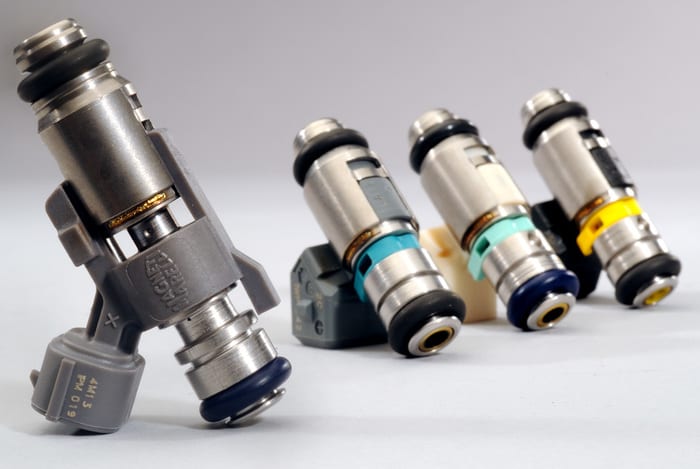
What is a nozzle: device, cleaning and checking
Content
Automobile engine injectors are one of the main elements of the injection and diesel engine power system. During operation, the nozzles become clogged, flow, fail. Read on for more details.
What is a nozzle?
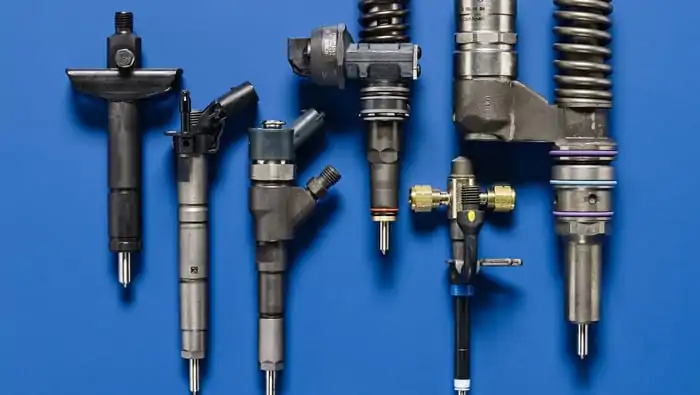
The nozzle is an integral part of the engine fuel system, which supplies fuel to the cylinders at a certain time in a certain amount. Fuel injectors are used in diesel, injector, as well as mono-injector power units. To date, there are several types of nozzles that are fundamentally different from each other.
Location and principle of operation
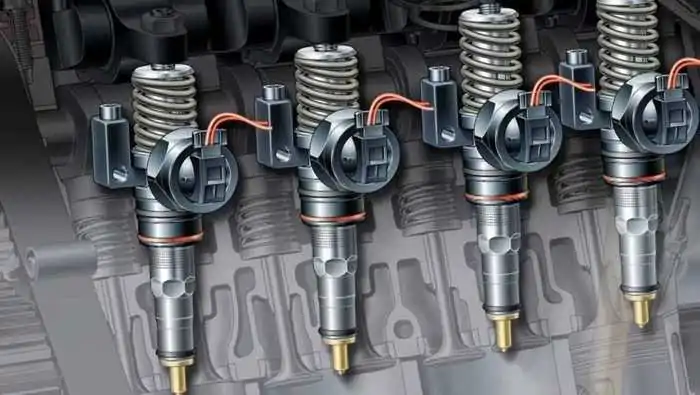
According to the type of fuel system, the nozzle can be located in several places, namely:
- central injection is a mono-injector, meaning that only one nozzle is used in the fuel system, mounted on the intake manifold, immediately before the throttle valve. It is an intermediate link between a carburetor and a full-fledged injector;
- distributed injection - injector. The nozzle is installed in the intake manifold, mixed with air entering the cylinder. It is noted for stable operation, due to the fact that the fuel washes the intake valve, it is less susceptible to carbon fouling;
- direct injection - nozzles are mounted directly in the cylinder head. Previously, the system was used only on diesel engines, and by the 90s of the last century, auto engineers began testing direct injection on an injector using a high-pressure fuel pump (high-pressure fuel pump), which made it possible to increase power and efficiency relative to distributed injection. Today, direct injection is widely used, especially on turbocharged engines.
Purpose and types of nozzles
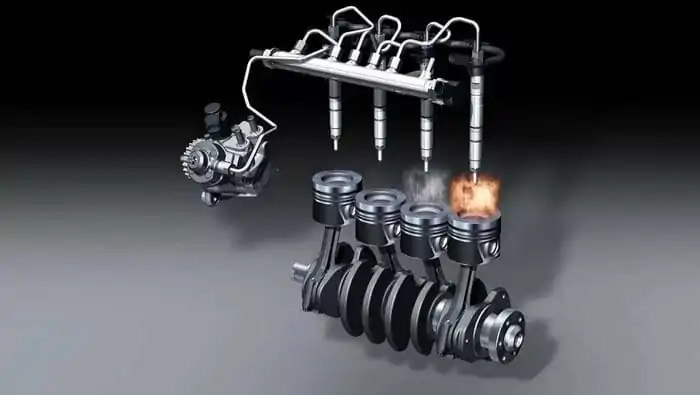
The nozzle is a part that injects fuel into the combustion chamber. Structurally, it is an electromagnetic valve that is controlled by an electronic engine control unit. The ECU fuel card contains the values, depending on the degree of engine load, the opening time, the time at which the nozzle needle remains open, and the amount of fuel injected is determined.
Mechanical nozzles
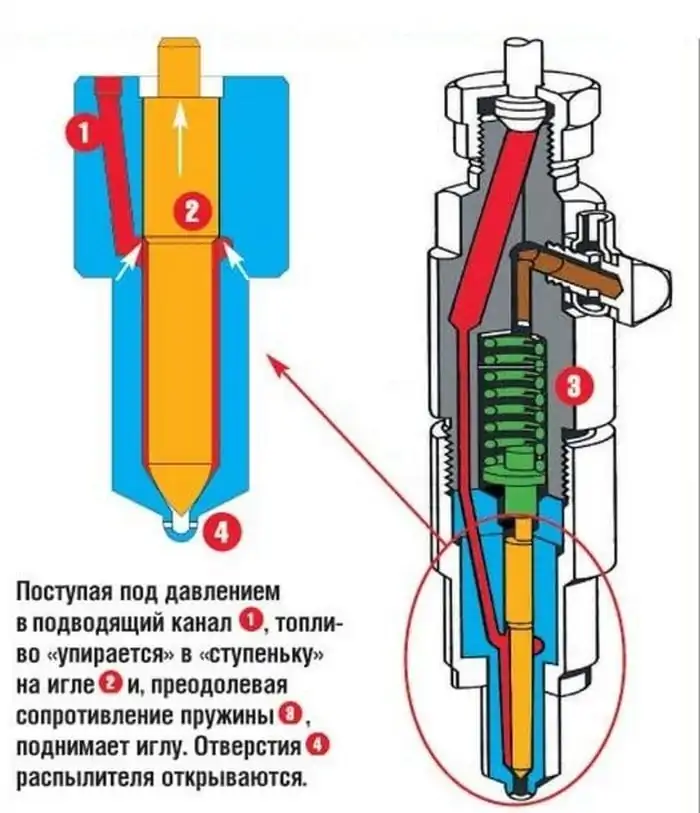
Mechanical injectors were used exclusively on diesel engines, it was with them that the era of the classic diesel internal combustion engine began. The design of such a nozzle is simple, as is the principle of operation: when a certain pressure is reached, the needle opens.
From the fuel tank to the high pressure fuel pump comes "diesel fuel". In the fuel pump, pressure is pumped up and diesel fuel is distributed along the line, after which a portion of the “diesel” under pressure through the nozzle enters the combustion chamber, after the pressure on the sprayer needle decreases, it closes.
The constructive solution of the nozzle is banal simple: a body, inside which a needle with a sprayer is mounted, two springs.
Electromagnetic nozzles
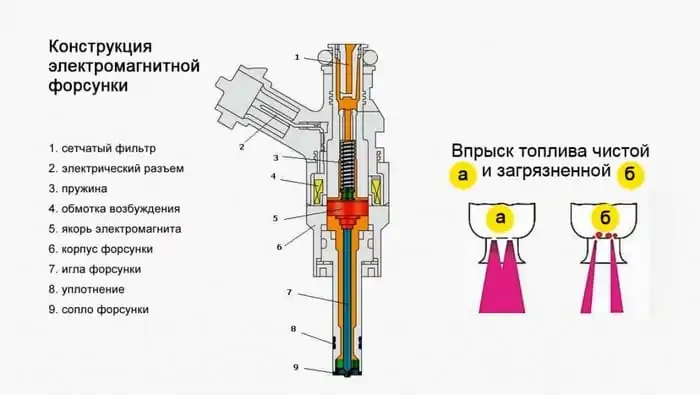
Such nozzles have been used in injection engines for over 30 years. Depending on the modification, the fuel is injected pointwise or distributed along the cylinder. The design is quite simple:
- a housing with a connector for connecting to an electrical circuit;
- valve excitation winding;
- electromagnet anchor;
- locking spring;
- needle, with sprayer and nozzle;
- sealing ring;
- filter mesh.
Principle of operation: The engine ECU sends voltage to the field coil, forming an electromagnetic field acting on the needle. At this moment, the spring force is weakened, the anchor is retracted, the needle rises to free the nozzle. The control valve opens and fuel enters the engine under a certain pressure. The computer sets the opening time, the time at which the valve remains open, and the moment the needle locks. This process is repeated all the work of the internal combustion engine, in a minute there is a minimum of 200 cycles.
Electro-hydraulic nozzles
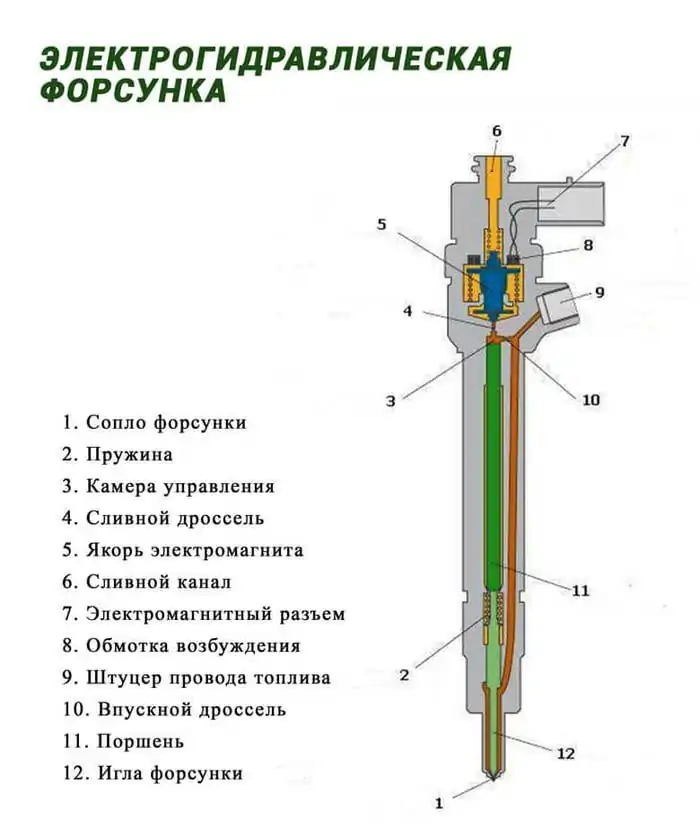
The use of such nozzles is made in diesel engines with a classical system (TNVD) and Common Rail. The electro-hydraulic nozzle consists of the following components:
- nozzle with a locking needle;
- spring with piston;
- control chamber with intake throttle;
- drain choke;
- field winding with connector;
- fuel supply fitting;
- drain channel (return).
Scheme of operation: the nozzle cycle begins with a closed valve. In the control chamber there is a piston, which is affected by fuel pressure, while the locking needle is tightly “sitting” on the saddle. The computer supplies voltage to the field winding and fuel is supplied to the nozzle.
Piezoelectric nozzles
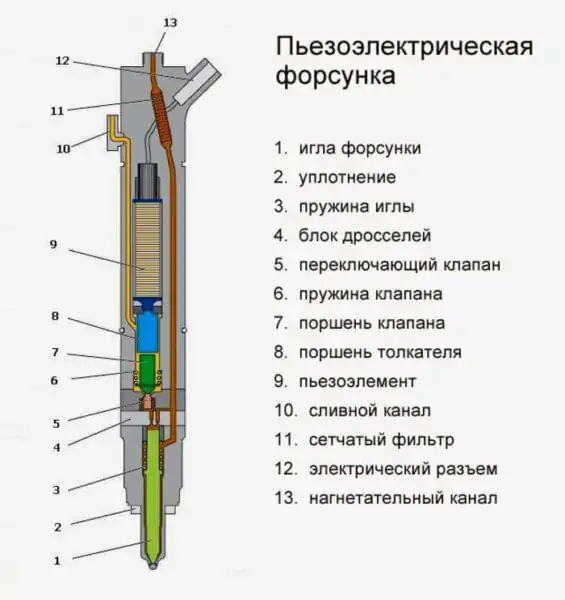
It is used exclusively on diesel engines. Today, the design is the most progressive, since the piezo nozzle provides the most accurate dosing, spray angle, quick response, as well as multiple spraying in one cycle. The nozzle consists of the same parts as the electro-hydraulic, only additionally has the following elements:
- piezoelectric element;
- two pistons (switching valve with spring and pusher);
- valve;
- throttle plate.
The principle of operation is carried out by changing the length of the piezoelectric element when applying voltage to it. When a pulse is applied, the piezoelectric element, changing the length, acts on the plunger piston, the switching valve is turned on and the fuel is supplied to the drain. The amount of diesel fuel injected is determined by the duration of the voltage supply from the computer.
Problems and malfunctions of engine injectors
In order for the engine to work stably and over time not to take more gasoline with worsening dynamics, it is necessary to periodically clean the atomizer. Many experts recommend performing such a preventive procedure after 20-30 thousand kilometers. Although this regulation is strongly influenced by the number of hours and the quality of the fuel used.
In a car that is often used in urban areas, moves along toffee, and refuels wherever it hits, the nozzles need to be cleaned more often - after about 15 thousand kilometers.
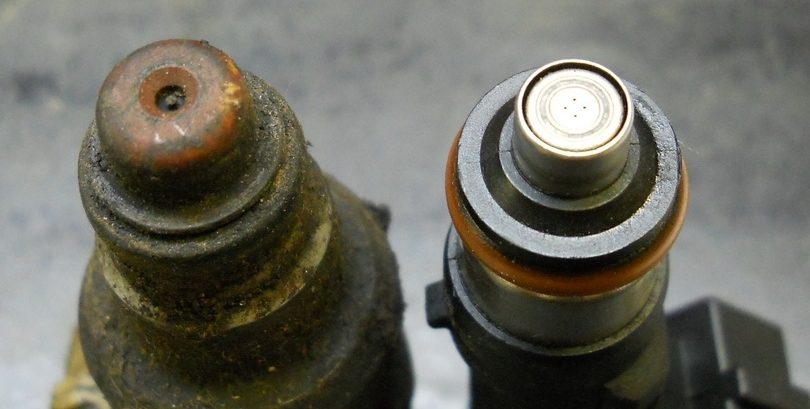
Regardless of the type of nozzle, its most painful place is the formation of plaque on the inside of the part. This often happens if low-quality fuel is used. Due to this plaque, the injector atomizer ceases to distribute fuel evenly throughout the cylinder. Sometimes it happens that the fuel just squirts. Because of this, it does not mix well with air.
As a result, a large amount of fuel does not burn, but is thrown into the exhaust system. Since the air-fuel mixture does not release enough energy during combustion, the engine loses its dynamism. For this reason, the driver has to press the gas pedal harder, which leads to excessive fuel consumption, and the dynamics of the transport continues to fall.
Here are a few signs that could indicate injector problems:
- Difficult start of the motor;
- Fuel consumption has increased;
- Loss of dynamism;
- The exhaust system emits black smoke and smells of unburned fuel;
- Floating or unstable idle (in some cases, the motor stalls completely at XX).
Reasons for clogged nozzles
The key causes of clogged fuel injectors are:
- Poor fuel quality (high sulfur content);
- Destruction of the inner walls of the part due to corrosion;
- Natural wear and tear of the part;
- Untimely replacement of the fuel filter (due to a clogged filter element, a vacuum may occur in the system that breaks the element, and the fuel begins to flow dirty);
- Violations in the installation of the nozzle;
- Overheat;
- Moisture got into the nozzle (this can happen in diesel engines if the car owner does not remove condensate from the fuel filter sump).
The issue of low-quality fuel deserves special attention. Contrary to popular belief that small grains of sand can clog the injector nozzle in gasoline, this happens extremely rarely. The reason is that all the dirt, even the smallest fractions, are carefully filtered in the fuel system while the fuel is supplied to the nozzle.
Basically, the nozzle is clogged with sediment from the heavy fraction of gasoline. Most often, it forms inside the nozzle after the driver turns off the engine. While the engine is running, the cylinder block is cooled by the cooling system, and the nozzle itself is cooled by the intake of cool fuel.
When the engine stops working, in most car models, the coolant stops circulating (the pump is rigidly connected to the crankshaft through the timing belt). For this reason, a high temperature remains in the cylinders for some time, but at the same time it does not reach the ignition threshold of gasoline.
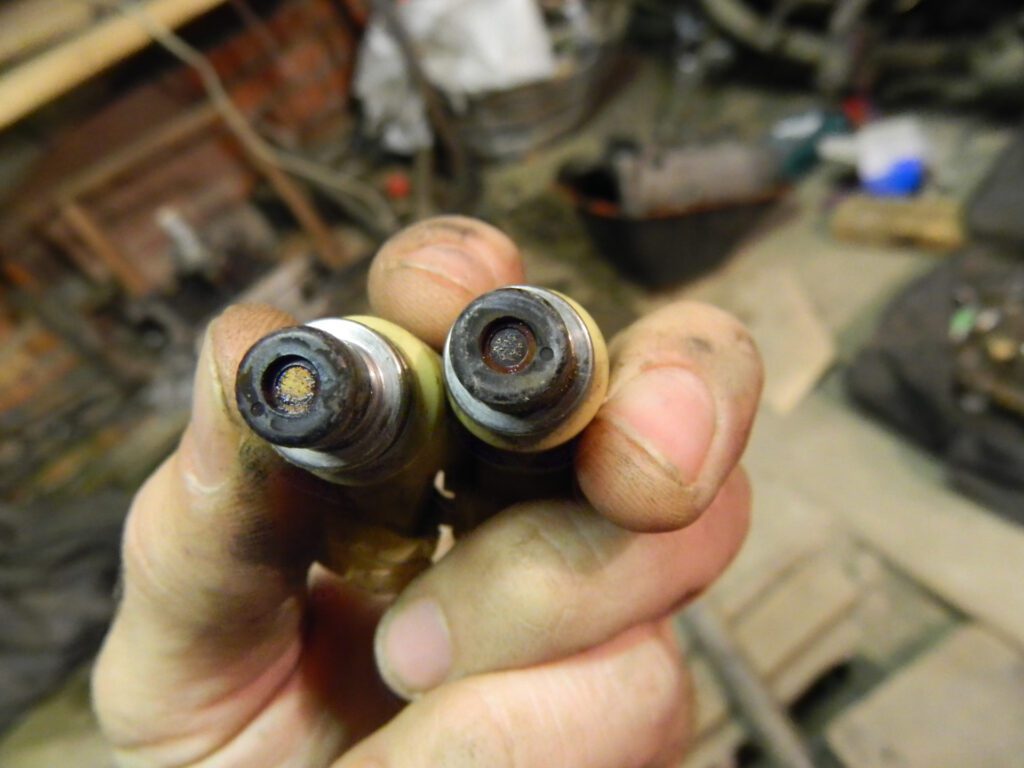
When the engine is running, all fractions of gasoline are completely burned. But when it stops working, small fractions dissolve due to high temperature. But heavy fractions of gasoline or diesel fuel cannot dissolve due to insufficient temperature, so they remain on the walls of the nozzle.
Although this plaque is not thick, it is enough to change the cross section of the valve in the nozzle. It may not properly close over time, and when detached, some particles may enter the atomizer and change the spray pattern.
Heavy fractions of gasoline are often formed when certain additives are used, for example, those that increase its octane number. Also, this can happen if the rules for transporting or storing fuel in large tanks are violated.
Of course, clogging of fuel injectors occurs slowly, which makes it difficult for the driver to notice a slight increase in engine gluttony or a decrease in vehicle dynamics. Much more often, the problem with the injectors manifests itself sharply with unstable engine speeds or difficult starts of the unit. But these signs are also characteristic of other malfunctions in the car.
But before starting to clean the injectors, the car owner must make sure that the poor performance of the engine is not related to other systems, such as malfunctions in the ignition or fuel system. Attention should be paid to the nozzles only after the other systems have been checked, the breakdowns of which have symptoms similar to those of a clogged injector.
How to clean nozzles
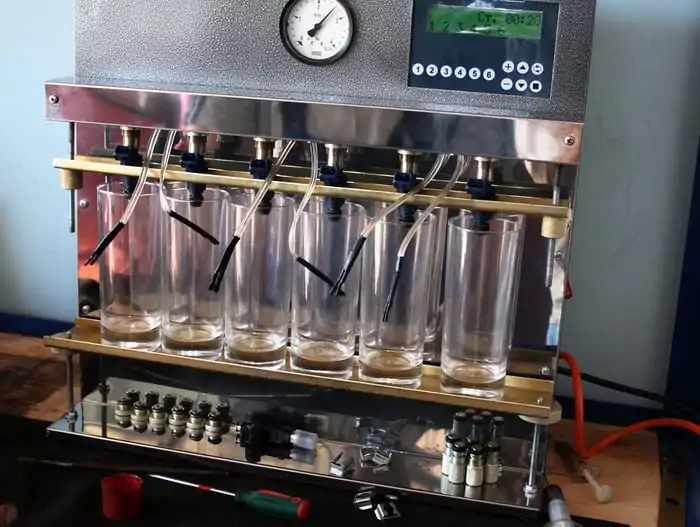
During operation, fuel nozzles become clogged. This is due to poor quality fuel, as well as untimely replacement of the fuel filter with fine and rough cleaning. As a result, the performance of the nozzle decreases, and this is fraught with an increase in temperature in the combustion chamber, which means that the piston will soon wear out.
It is easiest to rinse the nozzles of the distributed injection, since they are easier to dismantle for high-quality cleaning at the stand, while it is possible to equalize the throughput and the spray angle.
Cleaning with Wynns type detergent on a stand. The nozzles are installed on the stand, a liquid of at least 0.5 liters is poured into the tank, the nozzle of each nozzle is immersed in flasks divided by ml, which allows you to control the performance of the nozzles. On average, cleaning takes 30-45 minutes, after which the o-rings on the nozzles change and they are installed in their place. The frequency of cleaning depends on the quality of the fuel and the replacement range of the fuel filter, on average every 50 km.
Liquid cleaning without disassembly. A liquid system is connected to the fuel rail. The hose through which the cleaning fluid will be supplied is connected to the fuel rail. The mixture is supplied under a pressure of 3-6 atmospheres, the engine runs on it for about 30 minutes. The method is also effective, however, there is no possibility of adjusting the spray angle and performance.
Cleaning with a fuel additive. The method is often criticized as the effectiveness of mixing the detergent with the fuel is questionable. In fact, this works if the nozzles are not yet clogged, as a preventive measure - an excellent tool. Together with the nozzles, the fuel pump is cleaned, small particles are pushed through the fuel line.
Ultrasonic cleaning. The method only works when removing nozzles. The special stand is equipped with an ultrasonic unit, the effectiveness of which has been proven. After cleaning, tar deposits are removed that no washing liquid can wash away. The main thing is not to forget to change the filter mesh, if your nozzles are diesel or injection with direct injection.
Remember that after cleaning the nozzles, it is advisable to replace the fuel filter, as well as the coarse filter that is installed on the gasoline pump.
Cleaning nozzles with ultrasound
This method is the most complex and it is used in the most neglected cases. In the process of performing this procedure, all nozzles are removed from the engine, installed on a special stand. It checks the spray pattern before cleaning and compares the result after cleaning.
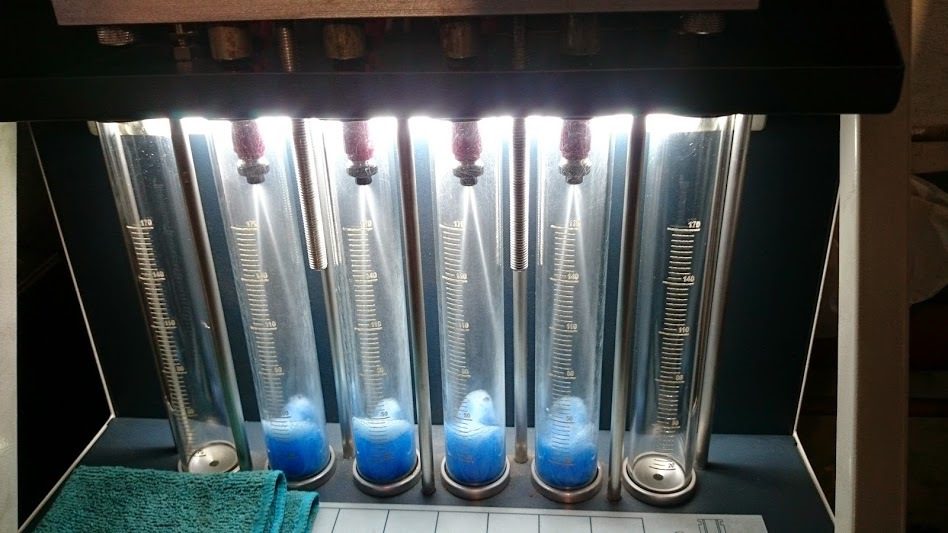
Such a stand imitates the operation of the injection system of a car, but instead of gasoline or diesel fuel, a special cleaning agent is passed through the nozzle. At this point, the flushing liquid forms small bubbles (cavitation) as a result of valve oscillations in the nozzle. They destroy the plaque formed in the part channel. At the same stand, the performance of the injectors is checked and it is determined whether it makes sense to use them further, or whether it is necessary to replace the fuel injectors.
While ultrasonic cleaning is one of the most effective methods, it is also the most expensive. Another disadvantage of ultrasonic cleaning is that a specialist will competently perform this procedure. Otherwise, the car owner will simply throw money away.
Advantages and disadvantages of injectors
All modern engines are equipped with an injection fuel system, because compared to a carburetor, it has several significant advantages:
- Thanks to better atomization, the air-fuel mixture burns completely. This requires a smaller amount of fuel, and more energy is released than when the BTS is formed by a carburetor.
- With lower fuel consumption (if we compare identical engines with a carburetor and an injector), the power of the power unit is significantly higher.
- With proper operation of the injectors, the engine starts easily in any weather conditions.
- There is no need to service the fuel injectors frequently.
But any modern technology has several serious drawbacks:
- The presence of a large number of parts in the mechanism increases potential breakage zones.
- Fuel injectors are sensitive to poor fuel quality.
- In the event of failure or the need for cleaning, replacing or flushing the injector is in many cases expensive.
Related videos
Here is a short video on how to flush fuel injectors at home:
Questions and answers:
What are engine injectors? It is a structural element of the fuel system of a car that provides a metered supply of fuel to the intake manifold or directly to the cylinder.
What types of nozzles are there? Injectors, depending on the type of engine and electronic system, can be mechanical, electromagnetic, piezoelectric, hydraulic.
Where are the nozzles in the car? It depends on the type of fuel system. In a distributed fuel system, they are installed in the intake manifold. In direct injection, they are installed in the cylinder head.